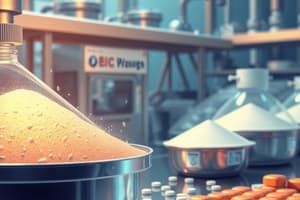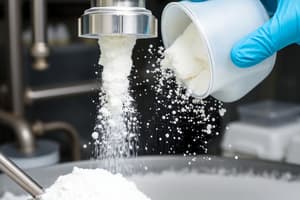Podcast
Questions and Answers
Why is the sifting process not suitable for incorporating potent drugs into a diluent powder?
Why is the sifting process not suitable for incorporating potent drugs into a diluent powder?
- It produces a non-uniform mixture
- It results in a light fluffy product (correct)
- It leads to excessive dust formation
- It is too quick and simple for such purposes
Which of the following processes is known to be thorough but time-consuming?
Which of the following processes is known to be thorough but time-consuming?
- Grinding
- Sifting
- Blending
- Tumbling (correct)
What type of product does the sifting process yield?
What type of product does the sifting process yield?
- Dense and compact
- Crystalline and clear
- Granular and moist
- Light and fluffy (correct)
What tool is likely used for mixing powders in the sifting process?
What tool is likely used for mixing powders in the sifting process?
What is a significant disadvantage of the tumbling process?
What is a significant disadvantage of the tumbling process?
Flashcards are hidden until you start studying
Study Notes
Powder Mixing
- Powder mixing involves passing powders through sifters to combine them, similar to sifting flour in a kitchen.
- The sifting process produces a light and fluffy end product.
- However, sifting is not suitable for combining potent drugs with a diluent powder.
Tumbling Method
- Tumbling involves mixing powders in a rotating chamber.
- This method provides a thorough mix, but it is a time-consuming process.
Studying That Suits You
Use AI to generate personalized quizzes and flashcards to suit your learning preferences.




